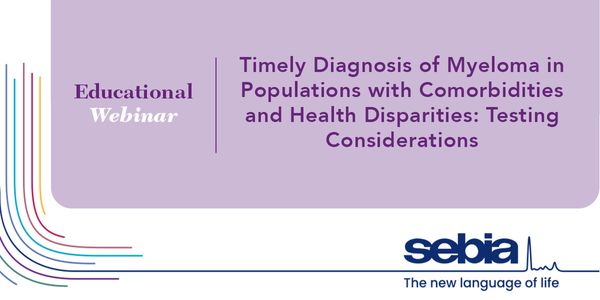WEBINARS
Our webinars allow users to learn from experts and earn continuing education credits on industry topics, progress in research, services available, and more.
Show More
-
On DemandC.E. CREDITSGenomic research has long been skewed toward European populations, leading to significant underrepresentation of Non-European groups in both research studies and genomic databases. This bias...
-
On DemandC.E. CREDITSPancreatic ductal adenocarcinoma (PDAC) is characterized clinically by poor survival and mechanistically by KRAS- and autophagy-dependent growth. We and others previously demonstrated that i...
-
SEP 25, 2024 | 8:00 AMC.E. CREDITSFluorescence microscopy offers robust, multi-parametric and scalable analysis of cell level activity in heterogenous populations with spatial and temporal resolution, often critical for effe...
-
SEP 25, 2024 | 7:00 AMC.E. CREDITSThe cellular physiology of microbes can vary significantly within a population, even when exposed to identical external conditions. Recent theoretical and experimental studies have shown tha...
-
SEP 19, 2024 | 11:00 AMC.E. CREDITSHeart failure, in the simplest of terms, indicates that a problem with the ventricles is preventing the heart from filling and/or pumping correctly. It is the result of a complex mechanical...
-
SEP 18, 2024 | 9:00 AMC.E. CREDITSabstract Learning Objectives Understand how the health disparity affects ordering M-protein testing at the right time. Discuss Analytical considerations of the test panel/methods ordered Ide...
-
SEP 18, 2024 | 8:30 AMC.E. CREDITSA unique opportunity to deepen understanding of how labs can contribute to antibiotic stewardship efforts by running efficient Procalcitonin testing, yielding significant impacts on patient...
-
SEP 10, 2024 | 10:00 AMC.E. CREDITSThe field of carrier screening has rapidly developed over the past several years, in terms of technology, guidelines for testing, and patient knowledge. This webinar aims to educate the audi...
-
AUG 29, 2024 | 9:00 AMC.E. CREDITS1) Microscope slides and coverglass are used in many parts of the lab while knowledge of how these items are made and the technical properties they have is limited. 2) By not understanding t...
-
AUG 28, 2024 | 9:00 AMC.E. CREDITSBlood Cultures are the gold standard test for Sepsis diagnosis and an essential first step in infectious organism identification. Improving its quality is critical to the outcomes for a pati...
-
AUG 27, 2024 | 9:00 AMC.E. CREDITSJoin Dr. Steben and Dr. Riedel in their discussion of the HPV landscape and the shift to primary screening. Dr. Steben will set the scene with a discussion of: HPV prevention and prevalence...
-
AUG 20, 2024 | 8:00 PMC.E. CREDITSNeural organoids derived from patient-specific iPSC lines can help open doors toward studying human brain development, physiology, and disease progression. The increased cell-cell interacti...
-
JUL 24, 2024 | 11:00 PMC.E. CREDITSSpatial transcriptomics offers a revolutionary approach to understanding the tumor microenvironment (TME) in solid tumors by preserving the spatial context of gene expression, which is cruci...
-
JUL 17, 2024 | 12:00 PMC.E. CREDITSRecently, the American Association of Clinical Chemistry (AACC), now Association of Diagnostics & Laboratory Medicine (ADLM), in collaboration with the American Diabetes Association (ADA...
-
JUL 10, 2024 | 10:00 AMC.E. CREDITSThyroid abnormalities affect a considerable portion of the population. Globally, there is a large population of people who have undiagnosed thyroid dysfunction or are at risk of developing i...
-
JUN 27, 2024 | 6:00 AMC.E. CREDITSHigh-resolution spatial transcriptomics stands at the forefront of technological advancements, offering transformative capabilities in the domain of tumor biology research. In this presentat...
-
JUN 25, 2024 | 9:00 AMC.E. CREDITSCytomegalovirus (CMV) is a ubiquitous infection and congenital CMV (cCMV) infection is the most common non-genetic cause of hearing loss in infants and children. However, most pregnant women...
-
JUN 12, 2024 | 3:00 PMC.E. CREDITSFine needle aspiration (FNA) plays a vital role in the evaluation of patients with thyroid nodules, in terms of distinguishing benign, non-neoplastic thyroid nodules that may be conservative...
-
MAY 29, 2024 | 9:00 AMC.E. CREDITSHistology laboratorians in the research world move fast, but those who perform cryosectioning know that these particular tissues require lighting speed and precision. Cryosectioning is the a...
-
MAY 23, 2024 | 10:00 AMC.E. CREDITSPrecise protein quantification is a crucial step in workflows involving protein extraction, isolation, and analysis. Accurate knowledge of the concentration of your protein sample is essenti...
-
MAY 22, 2024 | 9:00 AMC.E. CREDITSTuberculosis (TB) remains a leading global infectious disease killer, second only to COVID-191. It is an airborne disease caused by Mycobacterium tuberculosis bacteria and is responsible for...
-
MAY 16, 2024 | 3:00 PMC.E. CREDITSProstate cancer is the most common cancer in men and is second most common cause of cancer deaths. Importantly, the annual rates of prostate cancer incidence continue to rise. This session w...
-
MAY 14, 2024 | 9:00 AMC.E. CREDITSSurvival rates for patients with high grade serous carcinoma of the ovary (HGSC) have stagnated for the past fifty years. Despite the presence of tumor mutations and infiltration of immune c...
-
MAY 07, 2024 | 8:00 AMC.E. CREDITSAntibodies against ribonucleoprotein (RNP) are an important serologic marker for mixed connective tissue disease (MCTD). RNP interacts with Smith (Sm) proteins to form the Sm/RNP complex. An...
-
APR 25, 2024 | 3:00 PMC.E. CREDITSA comprehensive exploration of the latest advancements in the pathology of renal tumors. This one-hour webinar will explore the intricacies of renal tumor pathology, focusing on recent devel...
-
APR 24, 2024 | 8:00 AMC.E. CREDITSHas your research results or laboratory processes been bogged down by poor staining quality of histology slides? We all know that proper tissue processing is a key element to downstream stai...
-
APR 19, 2024 | 12:00 AMC.E. CREDITSDirect oral anticoagulants (DOACs), such as direct thrombin inhibitors and direct factor Xa inhibitors, are increasingly prescribed in various clinical scenarios for both adult and pediatric...

































































